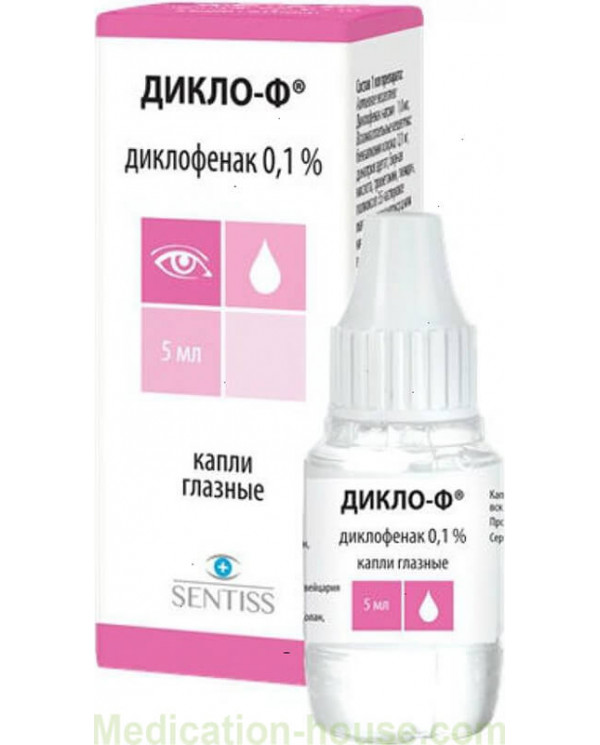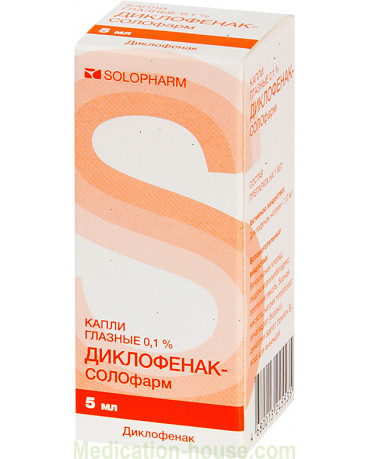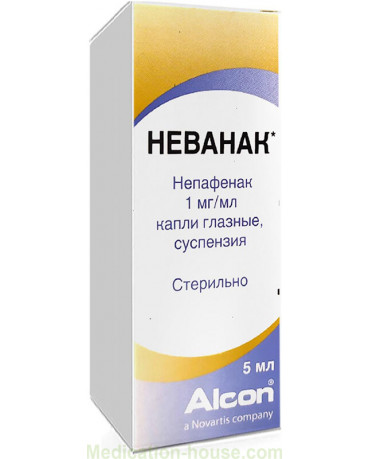Instruction for Diclo-F
Reed more and buy Diclo-F on this page
Release form and composition
The drug Diclo-F is made on the basis of the synthetic substance diclofenac sodium. It is a pale yellow ophthalmic drops at a concentration of 0.1%. Auxiliary compounds in the composition that enhance the anti-inflammatory effect:
Castor oil;
boric acid;
tromethamine;
polyoxyl 35.
As a preservative, the manufacturer declared: benzalkonium chloride, disodium edetate. The product is water-based and does not contain alcohol. It is released in glass or plastic vials, which are equipped with a convenient pipette with a dispenser. The solution is protected from sunlight by a cardboard box.
Pharmacodynamics and pharmacokinetics
The main substance diclofenac sodium has a pronounced anti-inflammatory effect. It lowers the temperature, acts on irritated nerve endings. After instillation and absorption by the tissues of the eye, an active production of prostaglandins is triggered - hormones that suppress pain, inflammation at the site of injury or injury.
Pharmacological effect from the use of Diclo-F drops:
decrease in miosis after surgical interventions;
reduction of pain syndrome;
localization of the inflammatory process in the sclera, on the fundus, mucous membranes;
normalization of the level of prostaglandins in the anterior chamber.
Diclofenac easily penetrates into all tissues, excluding the lens. After instillation, the analgesic effect is observed after 20 minutes at the maximum concentration of the substance after 30 minutes. The anti-inflammatory effect lasts for at least 6 hours.
The active substance enters the systemic circulation, but its concentration, with the correct dosage, does not disrupt the work of internal organs and systems. In clinical studies, it is detected in a minimal volume, excreted by the kidneys during metabolism.
Indications for use
The ophthalmic drops are recommended for use in the following cases:
prevention of miosis when removing cataracts on the lens or cornea;
conjunctivitis of non-infectious origin;
treatment of painful inflammations after trauma to the eye or mucous membranes;
prevention of edema after surgery;
pain after removing a foreign body, welding.
Diclo-F eye drops based on diclofenac are prescribed as an effective prophylactic agent that prevents the development of inflammation after surgery. It can be used simultaneously with antibiotics and antiseptics in the complex treatment of wounds.
Contraindications
The ophthalmic preparation in a minimal amount enters the bloodstream, affects the mucous membranes of the internal organs. Among the contraindications for the treatment of Diclo-F:
open forms of stomach and intestinal ulcers;
problems with hematopoiesis;
allergy to nonsteroidal anti-inflammatory drugs;
individual intolerance to acetylsalicylic acid.
With a restriction and only after the recommendation of a doctor, the medicine is used for the following pathologies:
herpetic form of keratitis;
hemophilia;
autoimmune diseases that disrupt the process of hematopoiesis.
The composition is used with caution in the treatment of patients over 55-60 years old. This is due to the presence of chronic diseases, hypertension, stomach problems, and digestion.
Instructions for use, method and dosage
If the patient is prescribed ophthalmic drops for pain relief, it is better to warm the solution to room temperature. Before use, you should wash your hands, do not touch the dispensing pipette with your fingers. The instruction provides for the introduction of the composition directly into the conjunctival sac.
Diclo-F eye drops instructions for use recommend dosing as follows:
To exclude cystic edema after surgery on the cornea or lens, the composition is instilled 1 drop 4 times a day. Treatment lasts at least 10-14 days.
After surgery to reduce inflammation and pain - 1 drop every 4 hours for 3 days, after which the interval can be increased.
To prevent miosis, the day before the operation, the medicine is dripped every 30-60 minutes at least 4 times.
The use of the solution after injury is recommended according to the scheme: 1 drop every 3-4 hours for 2-3 days. As the pain syndrome decreases, Diclo-F can be canceled.
Side effects
Diclo-F eye drops can provoke an allergic reaction if the dosage is violated or contraindications are neglected. Symptoms of drug intolerance are:
redness of the sclera;
hives on the skin;
fever;
swelling of the face and neck.
In 1-2 patients, diclofenac provokes the development of nausea, stomach cramps, and vomiting. In some patients, after therapy, there is a burning sensation, painful itching, and corneal opacity.
Special instructions
The active ingredients in the preparation are absorbed by the material from which the lenses are made. Therefore, before instilling eyes, they must be removed, used only after 15–20 minutes.
If the drug is used to relieve pain in an infection, you should avoid touching the mucous membrane of the inflamed eye. This threatens the secondary infection of a healthy organ. After use, the pipette-dispenser must be wiped with an antiseptic.
After instillation, a person may experience a temporary decrease in visual acuity. After application, you should not start performing work requiring precision, do not drive a vehicle.
Application during pregnancy and lactation
The manufacturer of the drug Diclo-F did not conduct separate studies confirming the complete safety of the drug for pregnant women and the fetus. But there is scientific evidence on the effects of sodium diclofenac: at a later date, it can disrupt blood circulation in the placenta, embryonic systems. During childbearing, doctors select safer counterparts.
Drug interactions
When taken simultaneously with other non-steroidal anti-inflammatory drugs, the risk of bleeding of the gastric or intestinal mucosa, ulcer perforation increases. If necessary, intensive treatment should adhere to a daily dose of 3 g.
The use of Diclo-F in the same course with coagulants and digitoxin enhances the anti-inflammatory effect. It is allowed to instill a drug with a hormonal component only after an interval of 5-10 minutes.
Terms and conditions of storage
The recommended shelf life of the drug from the date of manufacture is 2 years. After opening the bottle, the medicine loses its healing properties after 30 days.
Reviews
Victoria, 32 years old
I used medicinal drops for severe eye inflammation. I was tormented by pain and increased lacrimation. The ophthalmologist recommended Diclo-F to relieve painful symptoms. I applied 1 drop 4 times a day, relief came after the first procedure. After a course of 6 days, the problem practically disappeared.
Elena, 29 years old
After a painful operation, I had to look for a remedy for pain relief. According to reviews, I chose Diclo-F drops, which have an anti-inflammatory effect and protect against complications. Applied every 4 hours to reduce discomfort. Despite the listed contraindications and side effects, the treatment was easy, and within 10 days the problem completely disappeared, visual acuity was not impaired.
Terms of sell
You don't need a prescription to buy Diclo-F.



